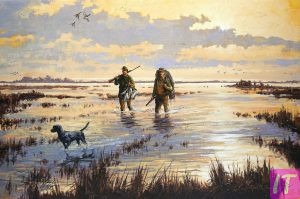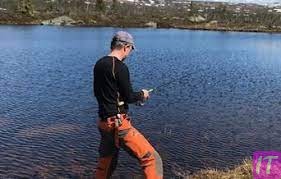Hunting and Fishing in the Wilderness
For centuries, hunting and fishing in the wilderness have not only provided sustenance for humankind but have also fostered a deep bond between people and nature. Whether pursued for survival, recreation, or conservation, these activities demand a profound understanding of the environment, mastery of techniques, and adherence to sustainable practices. This article delves into the intricacies of wilderness hunting and fishing, equipping enthusiasts with the knowledge and skills required to undertake these endeavors responsibly and efficiently.
Understanding the Fundamentals of Wilderness Hunting
Hunting in the wilderness involves activities targeting wild game in undisturbed natural environments. These areas are typically remote, free from significant human influence, and home to diverse wildlife. Hunters venture into these regions propelled by a mix of tradition, sport, and the necessity to manage wildlife populations.
Fundamentally, hunters must familiarize themselves with the behaviors and habitats of their target species. This entails understanding the seasonal movements, feeding patterns, and reproductive cycles of animals. Equally important is the capability to read the land—interpreting signs like tracks, droppings, and feeding sites.
Adequate preparation is indispensable. This encompasses physical conditioning to withstand challenging terrains and weather conditions, as well as mental readiness to make quick, ethical decisions. Furthermore, understanding the principles of ethical hunting, such as fair chase and respect for wildlife, forms the cornerstone of responsible hunting.
Wildlife observation is crucial. Spending time watching animals from a distance helps hunters learn their natural behavior, which is instrumental in predicting their movements during hunts. Additionally, proficiency in using maps and GPS devices ensures hunters can navigate unfamiliar territories effectively.
Wilderness hunting often involves prolonged periods of isolation, testing one’s endurance and survival skills. Thus, establishing a shelter, sourcing water, and preserving food are vital skills to master. Pre-trip planning, including emergency protocols and communication plans, enhances safety during expeditions.
Weather conditions significantly influence hunting strategies. Understanding weather patterns and their effects on animal behavior can increase the likelihood of a successful hunt. Equally important is the skill to adapt hunting techniques based on real-time environmental changes.
In essence, mastering wilderness hunting requires a holistic approach that blends knowledge of wildlife biology and behavior with proficiency in navigation, survival, and ethical practices. This foundation ensures hunters can engage in these activities safely and sustainably, reaping the benefits while contributing to wildlife conservation.

Essential Gear for Hunting in Remote Areas
The gear required for wilderness hunting differs markedly from that needed for more accessible areas, owing to the unique challenges posed by remote environments. Ensuring one has the appropriate equipment can mean the difference between a successful expedition and a perilous experience.
First and foremost, a reliable firearm or bow suited to the target game is crucial. This includes understanding how to maintain and repair the weapon in the field. Adequate ammunition or arrows should also be included, alongside cleaning kits to ensure the weapon remains functional.
Clothing should be selected based on the climate and terrain. Layered clothing systems, which provide warmth and moisture control, are ideal. Camouflage patterns that blend with the specific environment help in remaining inconspicuous to wildlife.
Footwear is another critical consideration. Sturdy, waterproof boots with good traction are essential for traversing rough, uneven ground. Investing in high-quality socks and gaiters can prevent blisters and keep feet dry.
Optics, such as binoculars and rifle scopes, enhance the ability to spot and accurately identify game from a distance. Similarly, a rangefinder is invaluable for estimating distances and making precise shots.
Safety gear, including a first aid kit, fire-starting tools, and a reliable GPS or map and compass, is non-negotiable. In addition, a personal locator beacon (PLB) or satellite phone can be lifesaving in emergencies when conventional communication methods fail.
Cooking and camping equipment tailored for lightweight travel ensures comfort. Compact stoves, non-perishable food items, and water purification systems enable hunters to sustain themselves throughout the expedition. A durable, weatherproof tent provides needed shelter.
Properly packing and organizing gear can streamline the hunting process. Utilizing a well-fitted backpack with compartments for different items can keep weight balanced and necessary tools within reach.
Additionally, taking into account hygiene essentials for extended stays in the wilderness is important. It includes biodegradable soaps, toothpaste, and items for personal care without leaving a trace.
Ultimately, every piece of gear chosen should prioritize functionality, durability, and weight, ensuring that the hunter is prepared to face the unpredictability of the wilderness.
The Ecological Impact of Wilderness Fishing
Wilderness fishing, while often viewed as a serene pastime, carries significant ecological implications that warrant careful consideration. Both positive and negative impacts can arise, influencing not only the aquatic ecosystem but also the broader environment.
On a positive note, regulated fishing can serve as a tool for conservation. Fishing licenses and permits generate revenue that funds conservation efforts, habitat restoration, and wildlife management programs. Moreover, engaging communities in sustainable fishing practices can foster a stewardship mindset.
However, overfishing poses a major threat to fish populations. The unsustainable harvest of fish, particularly spawning or breeding individuals, can lead to population declines and disrupt the ecological balance. Species-specific regulations, such as size and bag limits, help mitigate this risk but require strict enforcement.
Bycatch, the unintentional capture of non-target species, is another ecological concern. Bycatch can result in the injury or death of non-target fish, mammals, and reptiles, thereby affecting the overall biodiversity of the ecosystem. Using selective fishing gear and techniques can reduce bycatch and its associated impacts.
Aquatic habitat degradation is often a consequence of both recreational and commercial fishing. Physical alterations to shorelines, introduction of pollutants, and destruction of underwater habitats can have lasting detrimental effects. Sustainable fishing practices must prioritize minimal environmental disturbance.
Invasive species introduction, whether through discarded bait or careless gear transportation, can unbalance native ecosystems. Invasive species often outcompete, prey on, or introduce diseases to native species, leading to ecological disruptions. Vigilant cleaning, inspection, and control measures are essential to prevent such occurrences.
Additionally, climate change compounded by irresponsible fishing practices can exacerbate the vulnerability of fish populations. Rising temperatures and altered precipitation patterns affect water levels, temperature, and quality, challenging the survival of certain fish species. Fishing during appropriate seasons and times can help mitigate these pressures.
Educating anglers on the ecological impacts of their activities and promoting the ‘Leave No Trace’ principle ensures that fishing practices do not harm the environment. This includes proper disposal of waste, respecting wildlife habitats, and conducting activities in a manner that minimizes harm.
In summary, the ecological implications of wilderness fishing highlight the necessity for careful, informed practices that promote sustainability and conservation. Balancing human activities with the health of aquatic ecosystems is crucial for preserving these environments for future generations.
Techniques for Successful Big Game Hunting
Big game hunting is an endeavor that commands not only skill but also a profound understanding of the target species and their habitats. This pursuit requires a combination of techniques that enhance the chances of a successful hunt while prioritizing ethical considerations.
Scouting is a preliminary step that can significantly improve hunting outcomes. This involves researching and observing the terrain and animal behavior before the hunting season. Utilizing trail cameras and studying maps can provide insights into animal movement patterns and preferred habitats.
Calling techniques, using vocalizations or mechanical calls to mimic the sounds of target species, can attract big game. Mastery of calling requires practice and an understanding of the species’ communication behaviors. Responses to calls can vary based on the season, time of day, and the specific circumstances.
Stalking, the art of sneaking up on game, demands patience, keen observation, and the ability to move stealthily. Learning to read the wind direction, maintaining a low profile, and using natural cover can bring hunters within a desirable range of their targets without alerting the animals.
Spot and stalk is a combination technique that involves spotting game from a distance, often using binoculars or scopes, then planning and executing a strategic approach. This method is particularly effective in open landscapes where long-range visibility can be maximized.
Stand hunting, the practice of waiting in tree stands or ground blinds, relies on the hunter’s ability to predict and wait for the game’s arrival at specific locations. Placement of stands along travel routes, feeding areas, or water sources can increase the likelihood of encounters.
Tracking, following the signs left by game animals such as footprints, droppings, or broken vegetation, is fundamental in big game hunting. Understanding these signs can reveal an animal’s path and destination, helping hunters position themselves advantageously.
Ethical shot placement is critical for ensuring a humane kill. Hunters must be well-versed in the anatomy of their target species to aim for vital organs, reducing the suffering of the animal and facilitating a quicker retrieval.
Big game hunting often involves long-range shooting. Practicing marksmanship regularly and understanding ballistics is essential for making precise shots from a distance. Adjusting for factors like wind, elevation, and the animal’s movement ensures accuracy.
Increasingly, technology plays a role in big game hunting. Devices such as rangefinders, GPS units, and ballistic calculators can enhance precision and efficiency. However, reliance on technology should never supersede fundamental hunting skills and ethical considerations.
Ultimately, techniques for successful big game hunting involve a blend of traditional skills and modern tools, underpinned by a deep respect for wildlife and the principles of conservation. Practiced diligently, these methods contribute to the hunter’s success and the responsible stewardship of natural resources.
Sustainable Practices in Wilderness Fishing
Sustainable fishing practices are vital for maintaining healthy aquatic ecosystems and ensuring the long-term viability of fish populations. Responsible anglers must adopt strategies that minimize environmental impact and promote the conservation of fisheries.
Selective fishing, targeting specific species and sizes, helps maintain population balance. Adhering to size and bag limits ensures that only mature fish are harvested, allowing younger ones to grow and reproduce. This practice helps sustain fish populations by preventing overfishing of breeding individuals.
Catch and release, a practice where fish are caught and then carefully returned to the water, plays a crucial role in conservation. Understanding proper handling techniques, such as using barbless hooks and minimizing air exposure, increases the chances of fish survival post-release.
Using non-toxic tackle, such as lead-free sinkers and lures, prevents pollution and reduces the risk of poisoning wildlife. Lead and other toxic materials can contaminate water bodies and harm aquatic life. Environmentally friendly alternatives are readily available and equally effective.
Respecting fishing seasons and closures established by regulatory bodies ensures that fish populations can spawn and recover without disturbance. Seasonal restrictions are based on biological data and are critical for sustaining fish populations.
Habitat protection is integral to sustainable fishing. Avoiding actions that damage aquatic habitats, such as trampling vegetation or disturbing the lake bed, preserves the integrity of ecosystems that fish rely on. Monitoring and reporting habitat degradation can also contribute to conservation efforts.
Educating oneself and others about sustainable fishing practices fosters a culture of conservation among the angling community. Sharing knowledge about responsible techniques and the importance of preserving fisheries enhances collective efforts toward sustainability.
Participation in citizen science programs, such as reporting catch data or tagging fish, contributes valuable information to fisheries management. Data collected through these programs help scientists monitor fish populations and assess the effectiveness of conservation strategies.
Supporting conservation initiatives, whether through financial contributions or volunteer work, furthers efforts to protect and restore aquatic habitats. Engaging with organizations dedicated to fisheries conservation amplifies the impact of individual actions.
Finally, adhering to the principle of ‘Leave No Trace’ ensures that fishing activities do not negatively impact the environment. This includes proper disposal of waste, avoiding littering, and being mindful of the ecological footprint of one’s presence.
In summary, sustainable practices in wilderness fishing involve a combination of selective harvesting, conservation-minded techniques, and active participation in ecological preservation efforts. By adopting these practices, anglers can enjoy their pursuits while ensuring the health and longevity of aquatic ecosystems.

Navigating the Legalities of Hunting and Fishing Licenses
Acquiring hunting and fishing licenses is a legal requirement designed to regulate and preserve wildlife populations, ensuring the sustainability of these activities. Navigating the legalities associated with licensing can be complex but is essential for compliance and conservation.
Understanding the specific regulations in one’s region is the first step. Different states or countries have unique laws governing hunting and fishing activities, including season dates, permissible species, and allowable methods. Regulations may change annually based on conservation needs and population assessments.
Licensing processes often involve passing hunting education courses. These courses educate aspiring hunters on safety, ethics, and wildlife conservation principles. Completing these requirements not only fulfills legal obligations but also promotes responsible practices within the community.
Fishing licenses, similarly, come with regulations that vary by location and species. These licenses may include stipulations on catch limits, gear types, and the use of certain waterways. Familiarizing oneself with these rules helps prevent unintentional violations.
Specialized permits may be required for targeting specific species, particularly those classified as big game or threatened. These permits often come with additional regulations intended to protect vulnerable populations. Hunters and anglers must apply for and obtain these permits well in advance of their trips.
Bag limits and possession limits are critical legal constraints that dictate the number and size of animals or fish one can harvest. These limits prevent overharvesting and ensure that wildlife populations remain robust and sustainable.
Endorsements or stamps may be necessary for certain activities, such as using particular gear types or accessing specific areas. These endorsements signal compliance with additional regulations aimed at protecting specific habitats or species.
Private property considerations add another layer of complexity. Securing permission from landowners to hunt or fish on private lands is a legal and ethical requirement. Trespassing can result in fines and legal action, in addition to damaging the relationship between outdoor enthusiasts and landowners.
Licenses often come with reporting obligations. Hunters and fishermen may be required to report their harvests to wildlife agencies. These reports provide valuable data for managing wildlife populations and ensuring that regulations remain effective and adaptive.
Violations of licensing laws can result in severe penalties, including fines, license suspension, and even jail time. Therefore, thorough research and adherence to legal requirements are imperative for responsible participation in hunting and fishing activities.
Ultimately, navigating the legalities of hunting and fishing licenses involves a commitment to understanding and complying with regulations that support conservation efforts. Responsible hunters and anglers recognize that these legal frameworks are essential for the preservation of wildlife and natural resources for future generations.
Wildlife Management and Conservation Strategies
Effective wildlife management and conservation strategies are essential for maintaining biodiversity and ensuring the health of ecosystems. These strategies balance the needs of wildlife populations with human interests, promoting sustainability and resilience.
Habitat preservation is a cornerstone of wildlife management. Protecting and restoring natural habitats ensures that wildlife has access to the resources necessary for survival, such as food, water, and shelter. Conservation efforts often focus on mitigating habitat loss due to urbanization, agriculture, and infrastructure development.
Managing wildlife populations involves monitoring and regulating species numbers to prevent overpopulation or decline. Techniques include controlled hunting, habitat modification, and translocation. These practices help maintain ecological balance and prevent negative impacts on ecosystems.
Research and data collection underpin effective wildlife management. Field studies provide insights into species behavior, population dynamics, and habitat use. This data informs management decisions, such as setting hunting quotas, establishing protected areas, and developing recovery plans for endangered species.
Education and community involvement are crucial for successful conservation. Public awareness campaigns and educational programs foster a culture of conservation, encouraging people to support and participate in wildlife management efforts. Engaging local communities ensures that conservation strategies are socially acceptable and locally relevant.
Policy and legislation play a pivotal role in wildlife conservation. Laws and regulations, such as endangered species protection acts and wildlife trade bans, provide a legal framework for conservation efforts. Advocacy and policy development are essential for strengthening these protections and addressing emerging conservation challenges.
Restoration ecology focuses on rehabilitating degraded ecosystems. Techniques include reforestation, wetland restoration, and invasive species control. These efforts aim to restore ecological functions and improve habitat quality for wildlife.
In-situ and ex-situ conservation strategies complement each other in preserving species. In-situ conservation involves protecting species in their natural habitats, while ex-situ conservation includes captive breeding programs, seed banks, and botanical gardens. Both approaches are vital for safeguarding biodiversity.
Collaboration among stakeholders enhances the effectiveness of conservation efforts. Government agencies, non-governmental organizations, researchers, and local communities must work together to create and implement wildlife management plans. Partnerships and cross-sector cooperation are essential for addressing complex conservation issues.
Adaptive management is key to responding to changing environmental conditions and new scientific insights. This approach involves continuously evaluating and adjusting management strategies based on monitoring data and feedback. Adaptive management ensures that conservation efforts remain effective and resilient.
Ultimately, wildlife management and conservation strategies are multifaceted and dynamic, requiring a combination of science, policy, community involvement, and adaptive approaches. By integrating these elements, we can ensure the protection and sustainable use of wildlife resources for generations to come.
Survival Skills for Remote Hunting Expeditions
Survival skills are indispensable for hunters venturing into remote wilderness areas. The ability to sustain oneself and handle emergencies enhances safety and success during expeditions. Mastering these skills requires preparation, practice, and a thorough understanding of the environment.
Navigation is a critical survival skill. Proficiency in reading maps, using a compass, and operating GPS devices ensures that hunters can navigate unfamiliar terrain and avoid getting lost. Understanding natural navigation methods, such as using the position of the sun and stars, can also be lifesaving.
Shelter building enables hunters to create safe and comfortable living quarters in the wilderness. Techniques for constructing shelters vary based on available materials and environmental conditions. Familiarity with different types of shelters, such as lean-tos, debris huts, and snow caves, is essential.
Firecraft involves the ability to start and maintain a fire under various conditions. Fire provides warmth, cooking capabilities, and protection from predators. Hunters should carry multiple fire-starting tools, such as matches, lighters, and fire starters, and practice making fire with natural materials.
Water procurement is vital for survival. Knowing how to find and purify water from natural sources, such as streams, lakes, and rain, prevents dehydration. Techniques for water purification include boiling, using filtration systems, and chemical treatments.
Foraging skills enable hunters to identify and safely consume edible plants, berries, and fungi. Knowledge of local flora and the ability to distinguish between edible and toxic species are crucial. Additionally, understanding how to trap and hunt small game provides supplementary food sources.
First aid knowledge is essential for addressing injuries and illnesses in the field. Hunters should carry a comprehensive first aid kit and be trained in basic medical procedures, such as wound care, splinting fractures, and treating hypothermia and heatstroke.
Signaling for rescue is a key survival tactic. Carrying tools for signaling, such as whistles, mirrors, and signal flares, helps attract attention in emergencies. Understanding how to create ground-to-air signals and using radios or satellite phones for communication can also expedite rescue efforts.
Mental fortitude is often the most significant survival skill. Remaining calm, focused, and positive in challenging situations enhances decision-making and problem-solving abilities. Mental preparation and stress management techniques, such as deep breathing and visualization, can help maintain composure.
Preparedness is the foundation of wilderness survival. Thorough planning, including researching the area, preparing gear, and establishing emergency protocols, mitigates risks. Regularly practicing survival skills builds confidence and competence.
Ultimately, survival skills for remote hunting expeditions encompass a wide range of abilities that ensure safety, self-sufficiency, and adaptability. Mastering these skills empowers hunters to navigate and thrive in the wilderness, whether they face expected challenges or unforeseen emergencies.
Best Practices for Catch and Release Fishing
Catch and release fishing is a conservation







